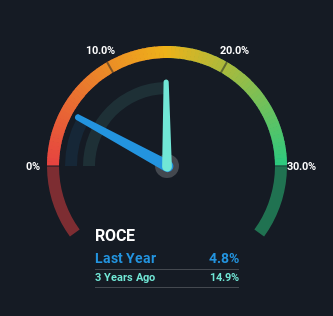- China
- /
- Communications
- /
- SZSE:300884
Returns On Capital Signal Tricky Times Ahead For Dnake (Xiamen) Intelligent Technology (SZSE:300884)
What trends should we look for it we want to identify stocks that can multiply in value over the long term? Firstly, we'll want to see a proven return on capital employed (ROCE) that is increasing, and secondly, an expanding base of capital employed. Ultimately, this demonstrates that it's a business that is reinvesting profits at increasing rates of return. In light of that, when we looked at Dnake (Xiamen) Intelligent Technology (SZSE:300884) and its ROCE trend, we weren't exactly thrilled.
Return On Capital Employed (ROCE): What Is It?
Just to clarify if you're unsure, ROCE is a metric for evaluating how much pre-tax income (in percentage terms) a company earns on the capital invested in its business. Analysts use this formula to calculate it for Dnake (Xiamen) Intelligent Technology:
Return on Capital Employed = Earnings Before Interest and Tax (EBIT) ÷ (Total Assets - Current Liabilities)
0.048 = CN¥68m ÷ (CN¥1.8b - CN¥422m) (Based on the trailing twelve months to March 2024).
So, Dnake (Xiamen) Intelligent Technology has an ROCE of 4.8%. On its own that's a low return, but compared to the average of 3.9% generated by the Communications industry, it's much better.
Check out our latest analysis for Dnake (Xiamen) Intelligent Technology

In the above chart we have measured Dnake (Xiamen) Intelligent Technology's prior ROCE against its prior performance, but the future is arguably more important. If you're interested, you can view the analysts predictions in our free analyst report for Dnake (Xiamen) Intelligent Technology .
The Trend Of ROCE
On the surface, the trend of ROCE at Dnake (Xiamen) Intelligent Technology doesn't inspire confidence. Around five years ago the returns on capital were 30%, but since then they've fallen to 4.8%. On the other hand, the company has been employing more capital without a corresponding improvement in sales in the last year, which could suggest these investments are longer term plays. It may take some time before the company starts to see any change in earnings from these investments.
On a related note, Dnake (Xiamen) Intelligent Technology has decreased its current liabilities to 23% of total assets. That could partly explain why the ROCE has dropped. Effectively this means their suppliers or short-term creditors are funding less of the business, which reduces some elements of risk. Some would claim this reduces the business' efficiency at generating ROCE since it is now funding more of the operations with its own money.
What We Can Learn From Dnake (Xiamen) Intelligent Technology's ROCE
Bringing it all together, while we're somewhat encouraged by Dnake (Xiamen) Intelligent Technology's reinvestment in its own business, we're aware that returns are shrinking. And in the last three years, the stock has given away 46% so the market doesn't look too hopeful on these trends strengthening any time soon. On the whole, we aren't too inspired by the underlying trends and we think there may be better chances of finding a multi-bagger elsewhere.
One more thing to note, we've identified 2 warning signs with Dnake (Xiamen) Intelligent Technology and understanding them should be part of your investment process.
While Dnake (Xiamen) Intelligent Technology isn't earning the highest return, check out this free list of companies that are earning high returns on equity with solid balance sheets.
New: Manage All Your Stock Portfolios in One Place
We've created the ultimate portfolio companion for stock investors, and it's free.
• Connect an unlimited number of Portfolios and see your total in one currency
• Be alerted to new Warning Signs or Risks via email or mobile
• Track the Fair Value of your stocks
Have feedback on this article? Concerned about the content? Get in touch with us directly. Alternatively, email editorial-team (at) simplywallst.com.
This article by Simply Wall St is general in nature. We provide commentary based on historical data and analyst forecasts only using an unbiased methodology and our articles are not intended to be financial advice. It does not constitute a recommendation to buy or sell any stock, and does not take account of your objectives, or your financial situation. We aim to bring you long-term focused analysis driven by fundamental data. Note that our analysis may not factor in the latest price-sensitive company announcements or qualitative material. Simply Wall St has no position in any stocks mentioned.
Have feedback on this article? Concerned about the content? Get in touch with us directly. Alternatively, email editorial-team@simplywallst.com
About SZSE:300884
Dnake (Xiamen) Intelligent Technology
Dnake (Xiamen) Intelligent Technology Co., Ltd.
Adequate balance sheet and slightly overvalued.
Market Insights
Community Narratives



